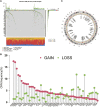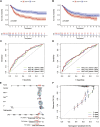Identification of pyroptosis-related subtypes, development of a prognostic model, and characterization of tumour microenvironment infiltration in gastric cancer
- PMID: 35923703
- PMCID: PMC9340157
- DOI: 10.3389/fgene.2022.963565
Identification of pyroptosis-related subtypes, development of a prognostic model, and characterization of tumour microenvironment infiltration in gastric cancer
Abstract
As a new programmed death mode, pyroptosis plays an indispensable role in gastric cancer (GC) and has strong immunotherapy potential, but the specific pathogenic mechanism and antitumor function remain unclear. We comprehensively analysed the overall changes of pyroptosis-related genes (PRGs) at the genomic and epigenetic levels in 886 GC patients. We identified two molecular subtypes by consensus unsupervised clustering analysis. Then, we calculated the risk score and constructed the risk model for predicting prognostic and selected nine PRGs related genes (IL18RAP, CTLA4, SLC2A3, IL1A, KRT7,PEG10, IGFBP2, GPA33, and DES) through LASSO and COX regression analyses in the training cohorts and were verified in the test cohorts. Consequently, a highly accurate nomogram for improving the clinical applicability of the risk score was constructed. Besides, we found that multi-layer PRGs alterations were correlated with patient clinicopathological features, prognosis, immune infiltration and TME characteristics. The low risk group mainly characterized by increased microsatellite hyperinstability, tumour mutational burden and immune infiltration. The group had lower stromal cell content, higher immune cell content and lower tumour purity. Moreover, risk score was positively correlated with T regulatory cells, M1 and M2 macrophages. In addition, the risk score was significantly associated with the cancer stem cell index and chemotherapeutic drug sensitivity. This study revealed the genomic, transcriptional and TME multiomics features of PRGs and deeply explored the potential role of pyroptosis in the TME, clinicopathological features and prognosis in GC. This study provides a new immune strategy and prediction model for clinical treatment and prognosis evaluation.
Keywords: gastric cancer; immunity; programmed death; pyroptosis; tumour microenvironment.
Copyright © 2022 Cao, Hu, Yuan, Cao, Cheng and Wang.
Conflict of interest statement
Author JH was employed by the company China Eastern Airlines Co., Ltd. The remaining authors declare that the research was conducted in the absence of any commercial or financial relationships that could be construed as a potential conflict of interest.
Figures








Similar articles
-
Identification of pyroptosis-related subtypes, the development of a prognosis model, and characterization of tumor microenvironment infiltration in colorectal cancer.Oncoimmunology. 2021 Oct 12;10(1):1987636. doi: 10.1080/2162402X.2021.1987636. eCollection 2021. Oncoimmunology. 2021. PMID: 34676149 Free PMC article.
-
Genomic, Immunological, and Clinical Characterization of Pyroptosis in Ovarian Cancer.J Inflamm Res. 2021 Dec 24;14:7341-7358. doi: 10.2147/JIR.S344554. eCollection 2021. J Inflamm Res. 2021. PMID: 34992421 Free PMC article.
-
Pyroptosis-Related Gene Signature Predicts Prognosis and Indicates Immune Microenvironment Infiltration in Glioma.Front Cell Dev Biol. 2022 Apr 25;10:862493. doi: 10.3389/fcell.2022.862493. eCollection 2022. Front Cell Dev Biol. 2022. PMID: 35547808 Free PMC article.
-
Pyroptosis impacts the prognosis and treatment response in gastric cancer via immune system modulation.Am J Cancer Res. 2022 Apr 15;12(4):1511-1534. eCollection 2022. Am J Cancer Res. 2022. PMID: 35530274 Free PMC article.
-
Pyroptosis-related prognosis model, immunocyte infiltration characterization, and competing endogenous RNA network of glioblastoma.BMC Cancer. 2022 Jun 3;22(1):611. doi: 10.1186/s12885-022-09706-x. BMC Cancer. 2022. PMID: 35658846 Free PMC article.
Cited by
-
Comprehensive multi-omics analysis of pyroptosis for optimizing neoadjuvant immunotherapy in patients with gastric cancer.Theranostics. 2024 May 5;14(7):2915-2933. doi: 10.7150/thno.93124. eCollection 2024. Theranostics. 2024. PMID: 38773976 Free PMC article.
-
Synergistic antitumor activity between HER2 antibody-drug conjugate and chemotherapy for treating advanced colorectal cancer.Cell Death Dis. 2024 Mar 5;15(3):187. doi: 10.1038/s41419-024-06572-2. Cell Death Dis. 2024. PMID: 38443386 Free PMC article.
-
Targeted Pyroptosis Is a Potential Therapeutic Strategy for Cancer.J Oncol. 2022 Nov 24;2022:2515525. doi: 10.1155/2022/2515525. eCollection 2022. J Oncol. 2022. PMID: 36467499 Free PMC article. Review.
-
Disulfidptosis-related gene SLC3A2: a novel prognostic biomarker in nasopharyngeal carcinoma and head and neck squamous cell carcinoma.Front Oncol. 2025 Jan 24;15:1451034. doi: 10.3389/fonc.2025.1451034. eCollection 2025. Front Oncol. 2025. PMID: 39926285 Free PMC article.
-
Pyroptosis and chemical classification of pyroptotic agents.Mol Divers. 2025 Jun;29(3):2765-2782. doi: 10.1007/s11030-024-10987-6. Epub 2024 Sep 24. Mol Divers. 2025. PMID: 39316325 Free PMC article. Review.
References
-
- Coussens L. M., Zitvogel L., Palucka A. K. (2013). Neutralizing tumor-promoting chronic inflammation: A magic bullet? Science 339 (6117), 286–291. [Journal Article; Research Support N.I.H., Extramural; Research Support, Non-U.S. Gov'tU.S. Gov't, Non-P.H.S.; Review]. 10.1126/science.1232227 - DOI - PMC - PubMed
-
- Dovedi S. J., Elder M. J., Yang C., Sitnikova S. I., Irving L., Hansen A., et al. (2021). Design and efficacy of a monovalent bispecific PD-1/CTLA4 antibody that enhances CTLA4 blockade on PD-1+ activated T cells. Cancer Discov. 11 (5), 1100–1117. Journal Article]. 10.1158/2159-8290.cd-20-1445 - DOI - PubMed
LinkOut - more resources
Full Text Sources
Research Materials
Miscellaneous

